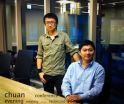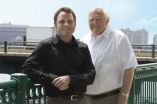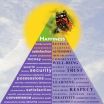Culture influences people's response to climate change
2011-06-30
(Press-News.org) How people choose to consume resources and use contraception influences their responses to climate change, according to a team of psychologists.
Janet K. Swim, professor of psychology, Penn State, and her colleagues report that growing consumption and growing population are two significant contributors to human impact on the environment. Both substantially increase carbon dioxide levels in the atmosphere, the researchers report in a special issue of American Psychologist that focuses on how psychology contributes to understanding and addressing global climate change.
"Engaging in one type of environmentally friendly behavior can predispose one to engage in similar behaviors, inhibit other behaviors, or even increase environmentally harmful behaviors," said Swim.
Swim and her colleagues reported that people's perceptions of how their behavior affects the environment influences how they act. If people do not believe that the choices they make will substantially improve the environment, then they are less likely to participate in activities like recycling, turning off lights when leaving a room or car pooling.
Some behaviors offset environmental gains. If a family buys a fuel-efficient vehicle but chooses to drive more miles than they previously did, there is no gain for the environment. Also, while the average U.S. household size is decreasing, Americans are generally choosing to live in larger homes, counteracting the energy savings on heating and cooling that could be made in smaller spaces.
Decisions about environmental consumption and behaviors that use environmental resources are influenced by culture as well as an individual's abilities and motivations, the researchers noted. Some cultural factors are structural. For example, as people began moving further away from city centers, cars became important for transportation. Other cultural factors, however, influence perceived needs and desires. The types of cars people drive and how fast people drive influence how much gasoline is consumed. People's cars and speed are often both influenced by advertising and others' purchasing and driving behaviors.
People adjust their explanations for behaviors in ways that allow them to maintain their consumer lifestyles. Carpool lanes decrease carbon dioxide emissions and lower costs of commuting. In one study on carpooler explanations for driving choices, the researchers noted that prior to the existence of carpool lanes commuters said carpooling was too expensive. After carpool lanes were available, commuters were surveyed again and reported that flexibility prevented them from carpooling.
Cultural and individual abilities and needs also influence contraceptive use. Population growth in India has in part been attributed to the importance placed on male children, creating a cultural need to have more children in order to increase the number of sons.
Individually people often consider the emotional value of children when determining how many children to have. However in some circumstances people consider the environmental effects as well. For example, in Nepal if people felt that "environmental destruction had influenced their agricultural productivity [they] were more likely to use contraceptives," the researchers said.
###
Also working on this research were Susan Clayton, professor and chair of environmental studies, College of Wooster, and George S. Howard, professor of psychology, University of Notre Dame.
END
ELSE PRESS RELEASES FROM THIS DATE:
2011-06-30
An emerging field of science termed "isoscapes" is making it possible to pinpoint the geographical origins of illegal drugs, trafficked endangered animals, dismembered human body parts at crime scenes, and even pricey scotch whiskey and cheese, according to an article in the current edition of Chemical & Engineering News (C&EN), the American Chemical Society's weekly newsmagazine.
In the article, Sarah Everts, C&EN European correspondent, explains how isoscapes has even led to development of one of the newest and most unusual maps of the world. It is a map showing the ...
2011-06-30
WASHINGTON, June 29, 2011 — Imagine a new genre of tiny implantable sensors, airborne and stationary surveillance cameras and sensors and other devices that operate without batteries on energy collected from the motion of a heart beat and have wireless communications capability. And the power plant for those devices is a "nanogenerator" that could even produce energy to charge an iPod from the movements of a person walking down the street.
That's the topic of a new episode in the American Chemical Society's (ACS) award-winning "Global Challenges/Chemistry Solutions" podcast ...
2011-06-30
NEW BRUNSWICK, N.J. – One-third of immigrant children and more than 70 percent of foreign-born, nonelderly adults living in New Jersey five years or less lack health coverage, a Rutgers statewide survey finds.
The report, "Health, Coverage and Access to Care of New Jersey Immigrants," by the Rutgers Center for State Health Policy (CSHP), also concludes immigrants face significant access-to-care barriers and their lack of health insurance is a much larger problem than for New Jerseyans born in the United States.
The research describes the health profile, insurance status ...
2011-06-30
A team of North Carolina State University researchers has discovered more about how a gene connected to the production of new brain cells in adults does its job. Their findings could pave the way to new therapies for brain injury or disease.
Most areas of the brain do not generate new brain cells, or neurons, after we are born. One exception is the olfactory bulb, the brain's scent processor, which continually produces new neurons. Dr. Troy Ghashghaei, assistant professor of neurobiology, had previously found a gene – known as Foxj1–connected to the production of an area ...
2011-06-30
DURHAM, N.C. -- So much for tagging photographs with names, locations and activities yourself – a new cell phone application can take care of that for you.
The system works by taking advantage of the multiple sensors on a mobile phone, as well as those of other mobile phones in the vicinity.
Dubbed TagSense, the new app was developed by students from Duke University and the University of South Carolina (USC) and unveiled at the ninth Association for Computing Machinery's International Conference on Mobile Systems, Applications and Services (MobiSys), being held in ...
2011-06-30
In 2009, the American Society of Civil Engineers (ASCE) assigned the grade "D" to the overall quality of infrastructure in the U.S. and said that ongoing evaluation and maintenance of structures was one of five key areas necessary for improving that grade. Since that time, federal stimulus funds have made it possible for communities to repair some infrastructure, but the field of high-tech, affordable methods for the continual monitoring of structures remains in its infancy. Instead, most evaluation of bridges, dams, schools and other structures is still done by visual ...
2011-06-30
CHESTNUT HILL, MA (June 29, 2011) – American artist Jackson Pollock's paintings often clashed with the rules of the art world. But they couldn't defy the laws of physics, according to a multidisciplinary team of researchers from Boston College and Harvard who give quantitative form to Pollock's methods and genius in the latest edition of the journal Physics Today.
Quantitative analysis is a phrase few would associate with Pollock, the abstract expressionist who during the 1940s and 50s adopted the method of pouring paint onto canvas in order to convey his artistic vision ...
2011-06-30
CHAMPAIGN, Ill. — In 1943, American psychologist Abraham Maslow proposed that all humans seek to fulfill a hierarchy of needs, which he represented with a pyramid. The pyramid's base, which he believed must come first, signified basic needs (for food, sleep and sex, for example). Safety and security came next, in Maslow's view, then love and belonging, then esteem and, finally, at the pyramid's peak, a quality he called
"self-actualization." Maslow wrote that people who have these needs fulfilled should be happier than those who don't.
In a new study, researchers at ...
2011-06-30
WASHINGTON—June 29, 2011—Nearly three-quarters (74%) of Georgia residents think spending money on research to improve health globally is important for economic development in Georgia, according to a new statewide poll commissioned by Research!America.
Eighty-one percent say global health is an issue about which Georgia residents should be concerned, and Georgians place a very high value on their state's leadership in research to improve health here and around the world: 96% say it is important for Georgia to be a leader in health research and development, and 81% say ...
2011-06-30
Palaeontologists have uncovered half-a-billion-year-old fossils demonstrating that primitive animals had excellent vision.
An international team led by scientists from the South Australian Museum and the University of Adelaide found the exquisite fossils, which look like squashed eyes from a recently swatted fly.
This discovery will be published tomorrow (Thursday 30 June 2011) in the prestigious journal Nature.
The lead author is Associate Professor Michael Lee from the South Australian Museum and the University of Adelaide's School of Earth & Environmental Sciences.
Compound ...
LAST 30 PRESS RELEASES:
[Press-News.org] Culture influences people's response to climate change



